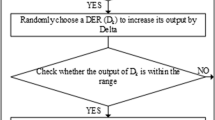Abstract
Smart grids aim to ensure the network reliability by providing electricity when it is demanded, while lowering the impact they have on the surrounding environment. Due to the great advances of renewable technologies, the current trend is to encourage the integration of renewable energy providers that could participate in satisfying the requested demand. The grid reliability can be achieved by identifying in advance the coalitions of heterogeneous electricity providers that could satisfy the forecast demand. This problem can be seen as an optimization problem aiming to identify the coalition that best satisfies the electricity demand curve over a particular period of time, by taking into account the energy supply forecast for each provider. In this context, this chapter proposes an optimization methodology for identifying the coalition of providers that satisfies the electricity demand curve over a time interval using an adapted version of the firefly algorithm. In our approach, each firefly has a solution with fixed length equal to the number of available energy providers. A solution element represents a tuple consisting of a provider and a flag which indicates whether the provider has been selected to provide energy or not. The objective function used to evaluate the quality of a solution is defined as the difference between the energy supplied by the solution’s providers and the demanded energy for the considered hour. Additionally, we have introduced in the fitness function, two penalty components that penalize a solution’s adherence to the requested provider heterogeneity and maximum desired price. To apply the firefly algorithm in this context, we have redefined the firefly movement strategy using the genetic crossover and mutation operators. The proposed optimization methodology has been evaluated on an in-house developed data set consisting of forecast energy values for energy supply and demand.
Access this chapter
Tax calculation will be finalised at checkout
Purchases are for personal use only
Similar content being viewed by others
References
Morales JM, Conejo AJ, Madsen H, Pinson P, Zugno M (2014) Integrating renewables in electricity markets—operational problems. Springer, New York, Heidelberg, Dordrecht, London
Renewable energy directive, https://ec.europa.eu/energy/en/topics/renewable-energy/renewable-energy-directive
Doulamis ND, Doulamis AD, Varvarigos E (2018) Virtual associations of prosumers for smart energy networks under a renewable split market. IEEE Trans Smart Grid 9(6):6069–6083
Hrvoje Pandzic, Igor Kuzle, Tomislav Capuder (2013) Virtual power plant mid-term dispatch optimization. Appl Energy 101:134–141
Yang X-S (2009) Firefly Algorithms for multimodal optimization. In: International symposium on stochastic algorithms SAGA 2009: stochastic algorithms: foundations and applications, pp 169–178
Classification of the optimization problems, https://neos-guide.org/optimization-tree
Michalewicz Z, Schoenauer M (1996) Evolutionary algorithms for constrained parameter optimization problems. Evol Comput 4(1):1–32
Yang X-S, He X (2013) Firefly Algorithm: recent advances and applications. Int J Swarm Intell 1(1)
Udaiyakumar KC, Chandrasekaran M (2014) Application of firefly algorithm in job shop scheduling problem for minimization of makespan. Procedia Eng 97:1798–1807
Mohanty DK (2016) Application of firefly algorithm for design optimization of a shell and tube heat exchanger from economic point of view. Int J Therm Sci 102:228–238
Hashim NL, Yusof Y, Hussain A (2016) The application of Firefly algorithm in an adaptive emergency evacuation centre management (AEECM) for dynamic relocation of flood victims. In: AIP conference proceedings
Mariam E, Zoubida B, Hanaa H, Aouatif A, Youssfi Elkettani (2017) Firefly algorithm for supply chain optimization. J Math 39(3):355–367
Dey N, Samanta S, Chakraborty S, Das A, Chaudhuri SS, Suri JS (2014) Firefly algorithm for optimization of scaling factors during embedding of manifold medical information: an application in ophthalmology imaging. J Med Imaging Health Inf 4(3):384–394
Chakraborty S, Dey N, Samanta S, Ashour AS, Balas VE (2016) Firefly algorithm for optimized nonrigid demons registration. In: Bio-inspired computation and applications in image processing. Academic Press, pp 221–237
Samanta S, Mukherjee A, Ashour AS, Dey N, Tavares JMR, Abdessalem Karâa WB, Hassanien AE (2018) Log transform based optimal image enhancement using firefly algorithm for autonomous mini unmanned aerial vehicle: An application of aerial photography. Int J Image Graph 18(04):1850019
Neeraj Gupta, Mahdi Khosravy, Nilesh Patel, Tomonobu Senjyu (2018) A bi-level evolutionary optimization for coordinated transmission expansion planning. IEEE Access 6:48455–48477
Roldán-Blay C, Escrivá-Escrivá G, Roldán-Porta C, Álvarez-Bel C (2017) An optimisation algorithm for distributed energy resources management in micro-scale energy hubs. Energy 132:126–135
Beraldi P, Violi A, Carrozzino G, Bruni ME (2018) A stochastic programming approach for the optimal management of aggregated distributed energy resources. Comput Oper Res 96:200–212
Vergados DJ, Mamounakis I, Makris P, Varvarigos E (2016) Prosumer clustering into virtual microgrids for cost reduction in renewable energy trading markets. Sustain Energy Grids Netw 7:90–103
Iriaa J, Soares F (2019) A cluster-based optimization approach to support the participation of an aggregator of a larger number of prosumers in the day-ahead energy market. Electr Power Syst Res 168:324–335
Mamounakis I, Vergados DJ, Makris P, Makris P, Doulamis ND (2017) Renewable energy prosumers clustering towards target aggregated prosumption profiles based on recursive predictions. In: 2017 IEEE Manchester powertech conference, pp 1–6
Acknowledgements
This work has been conducted within the eDREAM project Grant number 774478, co-funded by the European Commission as part of the H2020 Framework Programme (H2020-LCE-2017-SGS).
Author information
Authors and Affiliations
Corresponding author
Editor information
Editors and Affiliations
Rights and permissions
Copyright information
© 2020 Springer Nature Singapore Pte Ltd.
About this chapter
Cite this chapter
Pop, C.B., Chifu, V.R., Dumea, E., Salomie, I. (2020). A Firefly Algorithm-Based Approach for Identifying Coalitions of Energy Providers that Best Satisfy the Energy Demand. In: Dey, N. (eds) Applications of Firefly Algorithm and its Variants. Springer Tracts in Nature-Inspired Computing. Springer, Singapore. https://doi.org/10.1007/978-981-15-0306-1_3
Download citation
DOI: https://doi.org/10.1007/978-981-15-0306-1_3
Published:
Publisher Name: Springer, Singapore
Print ISBN: 978-981-15-0305-4
Online ISBN: 978-981-15-0306-1
eBook Packages: Intelligent Technologies and RoboticsIntelligent Technologies and Robotics (R0)




